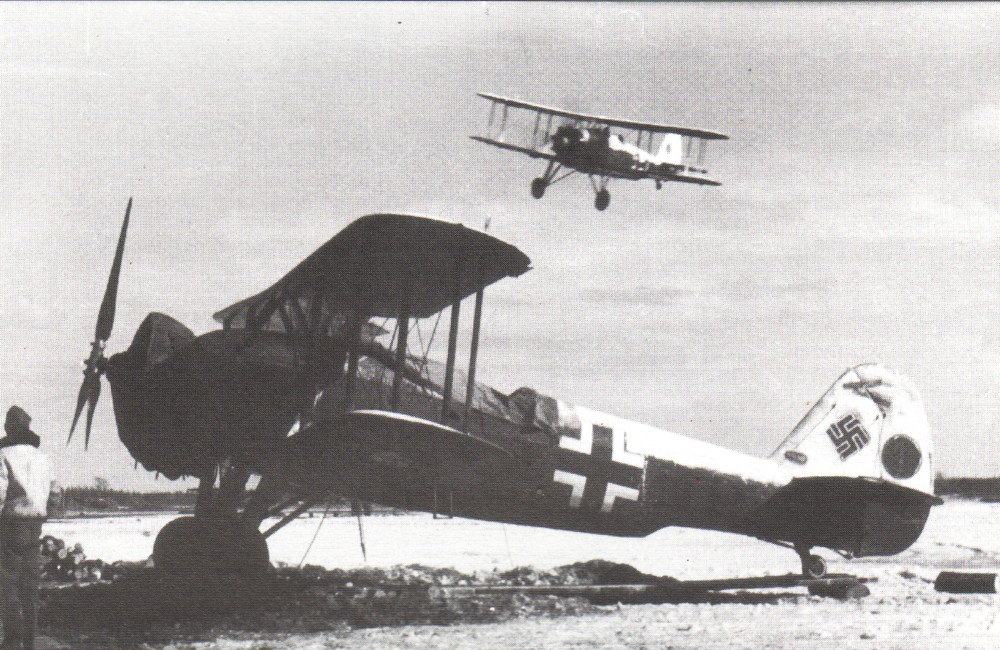- Heinkel He 50
infobox Aircraft
name =He 50
type =Dive-bomber
manufacturer =Heinkel 
caption =A Heinkel He 50 of a night ground attack unit on the Eastern Front.
designer =
first flight =1931
introduced =1935
retired = 1944
primary user =Luftwaffe
produced =
number built = 78
unit cost =
variants with their own articles =The Heinkel He 50 was a GermanWorld War II era dive-bomber originally designed for theImperial Japanese Navy . Serving inLuftwaffe pre-war dive-bombing units, the He 50 served almost until the end of World War II as a night harassment bomber.Design and development
In 1931, the Japanese Navy placed an order with the
Heinkel aircraft company for a two-seat dive-bomber capable of carrying 250 kg (551 lb) of bombs, stressed forcatapult launches, and capable of using either wheeled or floatundercarriage s.Eden and Moeng, 2002, p. 830.]A prototype, the Heinkel He 50aW, was completed in the summer of 1931. It was a
biplane of wood, steel tube construction and fabric covering. The aircraft had twin-floats for an undercarriage and was powered by aJunkers L5 engine. The engine was found to be underpowered. A second prototype, the He 50aL, was built, which was powered by a Siemens Jupiter VI engine and had a wheeled undercarriage. A second He 50aL was built and re-designated He 50b. Based on the He 50b, a third prototype designated Heinkel He 66 was completed for the Japanese Navy, and used as the basis of theAichi D1A Eden and Moeng, 2002, p. 831.] .The He 50 was an equal span biplane based on a rectangular-section
fuselage with a primary structure of welded steel tube construction, faired out to an oval shape by wooden formers and stringers and covered with fabric except in the extreme nose, which was skinned in light alloy. The wings were fabric covered wooden construction, marginally staggered and very slightly swept, and carriedaileron s on all four panels.Operational history
The He 50aL was re-designated He 50 V1 and demonstrated to the German Defence Ministry in 1932. This resulted in an order for three development aircraft, and a production batch of 60 He 50A-1 aircraft, which were built during the summer of 1933.
China placed an order for 12 He 50As, but modified with an enginecowling added and designated He 66b. These aircraft were commandeered by theLuftwaffe and re-designated He 50B. In 1935 the He 50 was delivered to the Luftwaffe’s first dive-bomber unit, and later partially equipped nine other dive-bombing units. The He 50, however, was steadily replaced by theHenschel Hs 123 andJunkers Ju 87 , after which He 50s were transferred to dive-bomber training units.In the spring of 1943, surviving He 50s were rounded up from training schools and delivered to night ground attack units operating on the Eastern Front. The He 50 was used to conduct night harassment sorties on the Eastern Front until September 1944, when the units were disbanded.
;He 50aW:First prototype as a floatplane, powered by a 291-kW (390-hp)
Junkers L5 inline piston engine, badly damaged in a forced landing.;He 50aL:Second prototype as a landplane, powered by a 365-kW (490-hp) Siemens Jupiter VI (Gnome-Rhone/Bristol) radial piston engine.;He 50b:Third prototype designated HE 66 for export to Japan, three more completed for German evaluation, powered by a 373-kW (600-hp)Bramo 322 B engine.;He 50A:Dive-bomber, reconnaissance version for theLuftwaffe . Sixty aircraft built.;He 50L:Redesignated of the HE 50A, production model, Heinkel produced 25, Bayerische Flugzeugwerke produced 35, powered by a 373-kW (600-hp) Bramo 322B engine.;He 66aCh:12 exported to China, powered by a 358 kW (480 hp) Siemens Jupiter VIIF (Gnome-Rhone/Bristol) radial piston engine.;He 66bCh:Powered by a Bramo 322B engine, 12 built for export to China, but impressed into Luftwaffe service as HE 50B, later delivered toHong Kong and remained in storage from January1936 until July1937 , transferred toPeking for limited service in the2nd Sino-Japanese War .;Aichi D1A1 :Some He 66 reconnaissance aircraft were built byAichi in Japan.;Aichi D1A2:Improved version of the Aichi D1A1.Operators
;JPN: one prototype HE 50b;China as ROC: 12 HE 66aCh, 12 HE 66bCh ;flag|Germany|Nazi: 60 HE 50A in
Luftwaffe serviceSpecifications (He 50A)
aircraft specification
plane or copter?=plane
jet or prop?=prop
ref= "German Aircraft of World War II" [Kay and Smith, 2002, p. 120.] and "The Complete Encyclopedia of World Aircraft"
crew= 2 (pilot, observer/gunner)
length main= 9.6 m
length alt= 31 ft 6 in
span main= 11 m
span alt= 37 ft 8¼ in
height main= 4.5 m
height alt= 14 ft. 9¾ in.
area main= 34.8 sq m
area alt= 374.59 sq ft
empty weight main= 1,600 kg
empty weight alt= 3,528 lb
loaded weight main=2,620 kg
loaded weight alt=5,778 lb
max takeoff weight main=
max takeoff weight alt=
engine (prop)=Bramo 322 B (SAM 22B)
type of prop=radial engine
number of props=1
power main= 485 kW
power alt= 650 hp
max speed main= 127 knots
max speed alt= 146 mph, 235 km/h
cruise speed main= 102.5 knots
cruise speed alt= 118 mph, 190 km/h
range main= 1000 km
range alt= 621 mi
ceiling main= 6,400 m
ceiling alt= 20,998 ft
climb rate main= 250 m/min
climb rate alt= 820 ft/min
loading main=
loading alt=
power/mass main=
power/mass alt=
armament=
* 1× 7.92 mm (0.31 in)MG 15 machine gun for rear seat.
* Up to 250 kg (551 lb) bomb load.ee also
aircontent
related=
*Aichi D1A
similar aircraft=
*SBC Helldiver
*Po-2 lists =
*List of military aircraft of Germany see also=
References
Notes
Bibliography
* Donald, D., ed. "Warplanes of the Luftwaffe: Combat Aircraft of Hitler’s Luftwaffe, 1933–1945". London: Aerospace Publishing, 2001. ISBN 1-8805888-10-2.
* Eden, Paul and Moeng, Soph, eds. "The Complete Encyclopedia of World Aircraft". London: Amber Books Ltd., 2002. ISBN 0-7607-3432-1.
* Kay, A.L. and Smith, J.R. "German Aircraft of World War II". Annapolis, Maryland: Naval Institute Press, 2002. ISBN 1-55750-010-X.External links
* [http://avia.russian.ee/air/germany/he-50.php Heinkel He 50]
* [http://www.warbirdsresourcegroup.org/LRG/he50.html WRG - Luftwaffe Resource Group - Heinkel He 50]
Wikimedia Foundation. 2010.
